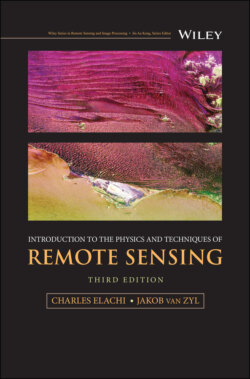Читать книгу Introduction to the Physics and Techniques of Remote Sensing - Jakob J. van Zyl - Страница 12
1 Introduction
ОглавлениеRemote sensing is defined as the acquisition of information about an object without being in physical contact with it. Information is acquired by detecting and measuring changes that the object imposes on the surrounding field, be it an electromagnetic, acoustic, or potential field. This could include an electromagnetic field emitted or reflected by the object, acoustic waves reflected or perturbed by the object, or perturbations of the surrounding gravity or magnetic potential field due to the presence of the object.
The term “remote sensing” is most commonly used in connection with electromagnetic techniques of information acquisition. These techniques cover the whole electromagnetic spectrum from the low‐frequency radio waves through the microwave, submillimeter, far infrared, near infrared, visible, ultraviolet, x‐ray, and gamma‐ray regions of the spectrum.
The advent of satellites is allowing the acquisition of global and synoptic detailed information about the planets (including the Earth) and their environments. Sensors on Earth‐orbiting satellites provide information about global patterns and dynamics of clouds, surface vegetation cover and its seasonal variations, surface morphologic structures, ocean surface temperature, and near‐surface wind. The rapid wide coverage capability of satellite platforms allows monitoring of rapidly changing phenomena, particularly in the atmosphere. The long duration and repetitive capability allows the observation of seasonal, annual, and longer term changes such as polar ice cover, desert expansion, solid surface motion, and subsidence and tropical deforestation. The wide‐scale synoptic coverage allows the observation and study of regional and continental scale features such as plate boundaries and mountain chains.
Sensors on planetary probes (orbiters, flybys, surface stations, and rovers) are providing similar information about the planets and objects in the solar system. By now all the planets in the solar system have been visited by one or more spacecraft. The comparative study of the properties of the planets is providing new insight into the formation and evolution of the solar system.
